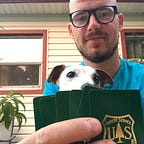Fix Cities, Not Trucks
If you spend enough time roaming around the urban planning internets, you’ll probably find a few articles about how SUVs and pickup trucks are getting taller and more square in order to feed the macho American ego, and that this is leading to higher pedestrian deaths. A couple of good examples can be found here and here. I’m not going to argue with that narrative or that problematic truck owners don’t exist. Instead, I’m going to say that the majority of truck and SUV owners are simply using their tools in a very different context than they were intended, and urban design needs to change to fix that.
Trucks: What are they good for?
A lot of things. Truck beds are super versatile, a 4x4 can go a lot of interesting places in a lot of conditions. If you’re a hiker, hunter, mountain biker, skier, or DIYer, you have probably thought that it would be nice to have a pickup. As a person who is all of the above, I feel justified in owning my F-150. It gets used for hauling dogs, drywall, bikes, dirt, and a bunch of other stuff that isn’t feasible on foot or bike. They’re also great for road trips. Friends in the front, gear in the back.
Cars: What are they good for?
The same things that trucks are good for, but smaller. With the exception of long trips, I would argue that there’s nothing that a car can do that my cargo bike can’t:
Cargo bikes are much safer, efficient, and community friendly than even the smallest automobile. This leads me to the crux of my argument: Automobiles, buses, bikes, and feet are transportation tools, and we have been using them wrong.
Quick Primer: The Stroad
Strong Towns explains this all very well, so I’m not going to get too detailed. A Street is a place for people to live, work, and be engaged in community. A road is infrastructure intended to move people quickly between places. A stroad is the fuzzy middle space that is too common in American cities:
- High speed (40–55 mph speed limit)
- Lots of access points
- Multiple highway-width lanes
- If there are sidewalks, they’re inadequate and uncomfortable places for people to be
- Long distances between pedestrian crossings
Stroads are built with the intention of both providing opportunities for development and businesses and “efficient” travel between places.
Stroads are for Cars, Cars are Stroady
Most American cities and suburbs are built for people to drive around in and are generally not great for walking or biking. As a result, people use the tool that is the best fit for the place, their automobile. They need a tool that meets their needs, so if they have a large family, are outdoorsy, or are handy, that tool is most likely going to be a pickup or SUV. While this is not the best tool for getting them up and down the stroad, on the whole it fits their lifestyle better. Small cars are the compromise choice between over-the-road mobility and fitting into urban spaces, much like the stroad.
Planners should be counting the trend of increased truck ownership as a win. Driving a big vehicle in the streets portion of a city is a pain. Parking garage stalls on their own should be enough of a deterrent to discourage driving. This is because trucks and SUVs are built for roads, not streets. As I said before, they’re great for road trips. That high, blunt front end that is terrible for pedestrians is an important safety feature if the tool is being used properly. Replace the pedestrian with a deer and the design that is intended to send the obstacle down and under the vehicle instead of through the windshield makes a lot more sense.
More Streets and Roads
The solution is not to demand auto manufacturers to change their designs or to encourage everyone to go get a small car instead of a truck. As I said, trucks are great for circumstances that bikes and walking are not. I would also argue that this tactic plays into the narrative that “city folk are trying to control rural America” in an unhelpful way. The solution is to get people to stop driving so much in cities, and when they do, make them do it really slowly. Road diets, curb extensions, better land use decisions, better transit, and much, much, less free parking are the ways to encourage the use of the best tool for the job.
